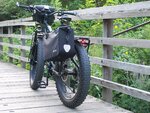Yamahonian
Active Member
I have a new bike with a Yamaha PW-X Motor and 500wH Yamaha battery.
On today's ride, I began with 92% charge. The expected range, on the high power setting, was 51 miles at the start of my trip.
I rode a total of 28 actual miles, and ended my day with 10% charge remaining.
Therefore, I got 28 miles out of 82% battery charge. Not nearly what I was expecting.
Outside temperature was about 42 degrees. I ride with an upright seating position (stem riser). Not an overly windy day. It was a completely flat bike trail, I am mainly riding in the three smallest rear cogs. Average 15mph.
Does that sound right, or is there something wrong with my battery?
On today's ride, I began with 92% charge. The expected range, on the high power setting, was 51 miles at the start of my trip.
I rode a total of 28 actual miles, and ended my day with 10% charge remaining.
Therefore, I got 28 miles out of 82% battery charge. Not nearly what I was expecting.
Outside temperature was about 42 degrees. I ride with an upright seating position (stem riser). Not an overly windy day. It was a completely flat bike trail, I am mainly riding in the three smallest rear cogs. Average 15mph.
Does that sound right, or is there something wrong with my battery?
